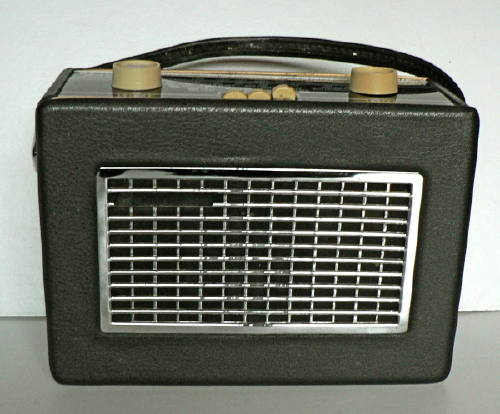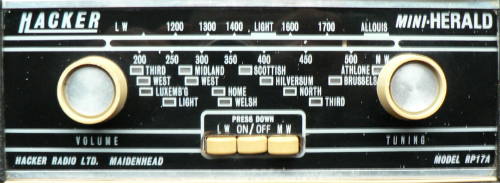
Serial number 81503

Portable Transistor radio Made by Hacker Radio Ltd, Maidenhead UK. The radio is housed in a dark blue leatherette covered wooden case. It was given to me by Roddie MacKenzie. Although the Hacker Logo is missing, the strap is in good condition.This is a good quality radio with 7 transistors covering medium and long wavebands. It has sockets for headphones and external aerial (on left and right hand sides). This radio is normally powered by two 9 volt PP9 batteries in series. now working Maidenhead, UK 1962 approx.

Perspex Dial
The radio was connected to a variable voltage power supply as I did
not have two 9 Volt batteries and wen the radio was first energised
there was complete silence. The loudspeaker and the earphone socket
proved to be OK. As I have another RP17A it was an easy matter to test
the output stage by using the front end of the second one to provide
the signal and power for the output stage. In this way it was
established that the fault lay in the main part of the circuit.
It was apparent that the pushbutton switches were not working properly,
as it was not possible to switch the set off. I left the set connected
on the work bench, switched off the main power supply and spent a week
doing other things. When next energised the set came to life (at least
on the Long Waveband). This was a relief, I had suspected that one of
the dreaded AF117 transistors might be at fault and this seemed to be
the case as tapping one of them caused the radio to become silent
again.
These germanium transistors manufactured by Mullard are housed in tin
plated cans. The cans are connected to a fourth lead out wire which is
normally connected to the "earthy" side of the circuitry, the purpose
being to act as a screen or shielding. Unfortunately the tin grows
whiskers a few microns thick inside the casing and these, if long
enough, can make contact with the germanium junction and effectively
short circuit the transistor.
There are several remedies:
1. Replace the transistor
2. Cut the fourth lead
3. Blow up the whiskers by connecting an electrolytic capacitor charged
to 50 Volts between the casing and all the other leads connected
together.
4. Separate the can from the base by unsoldering and physically
removing the whiskers.
5. Merely heating the top of the can with a soldering iron has been
said to do the trick.
I tried method 3 on the oscillator transistor without success and ended
up using method 2 on all three AF117 transistors. The set then came to
life and has been working for some hours.
Of course there is the possibility that there might be two or more
whiskers touching the transistor junctions and merely cutting the
screen lead wire might have no effect as the short circuit would be
within the casing.

